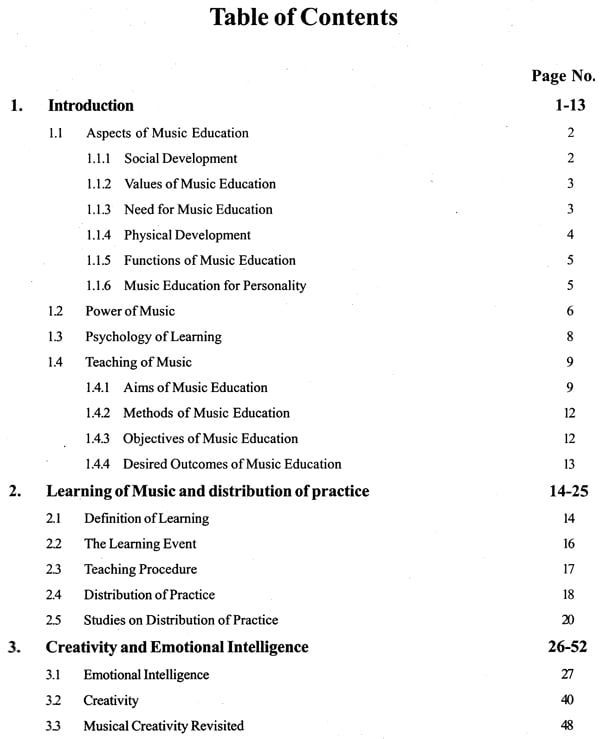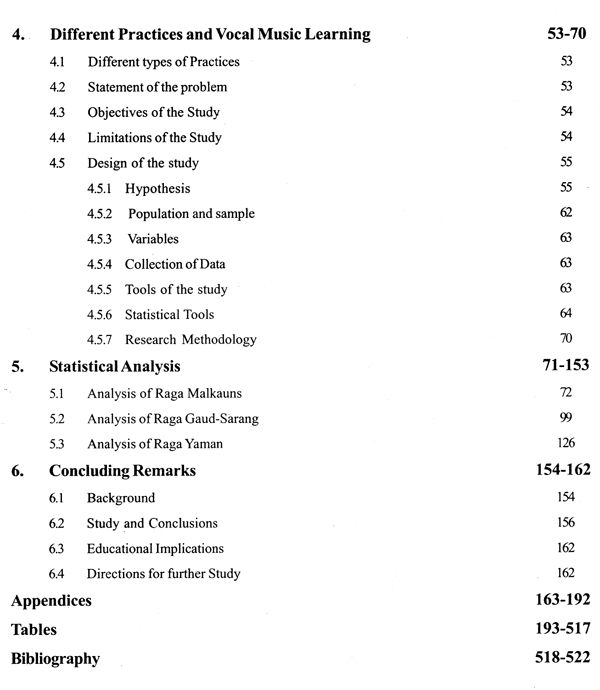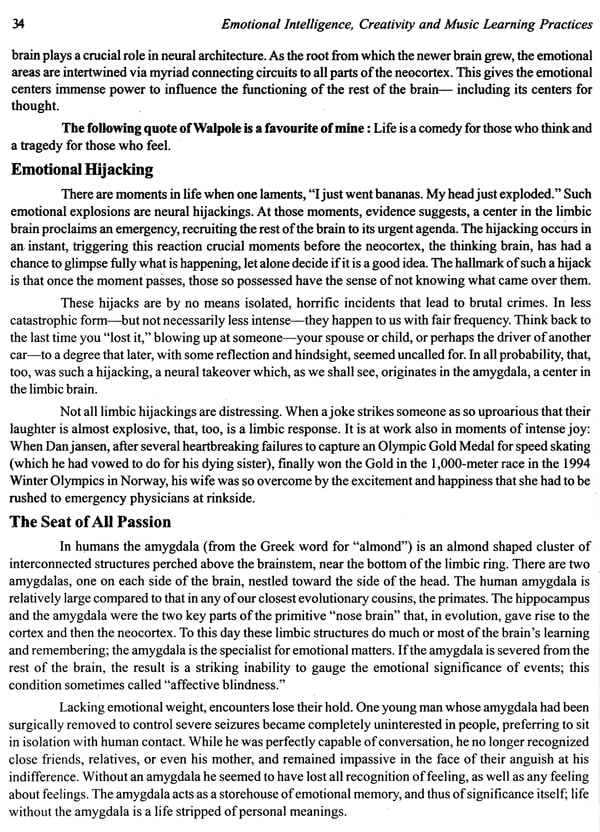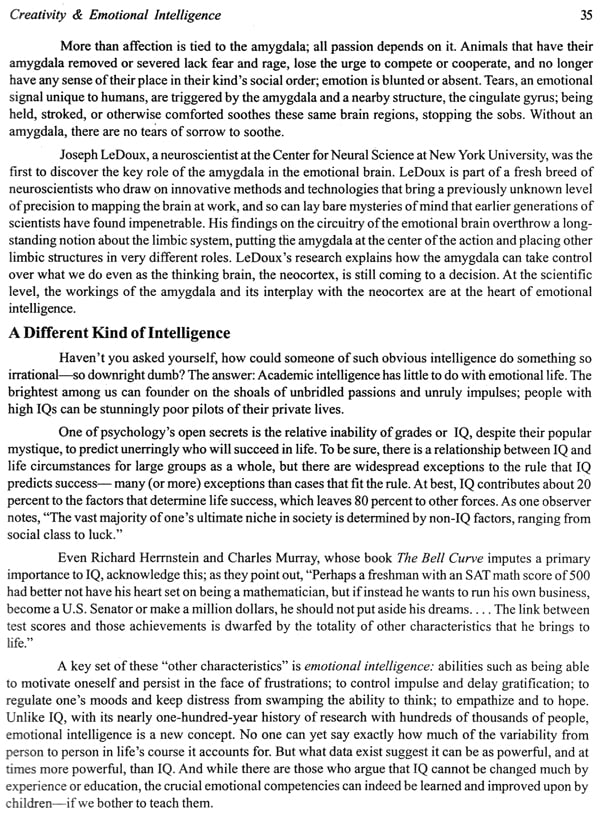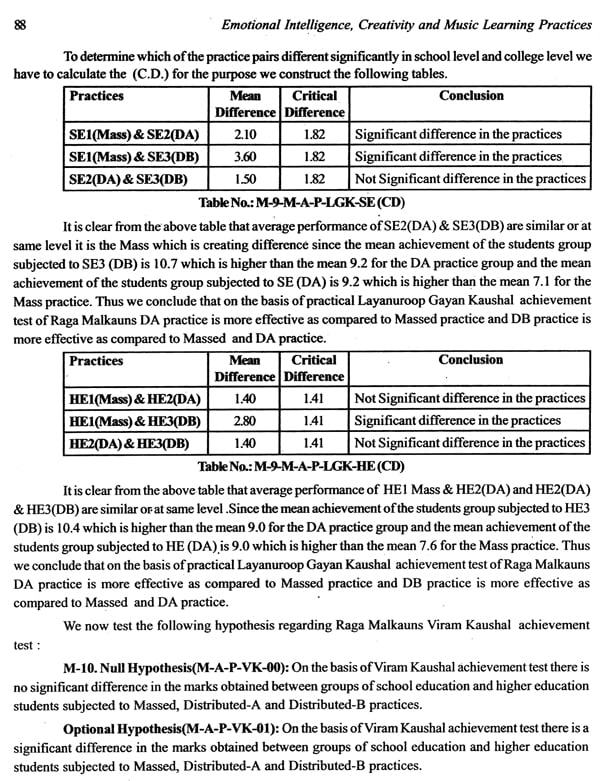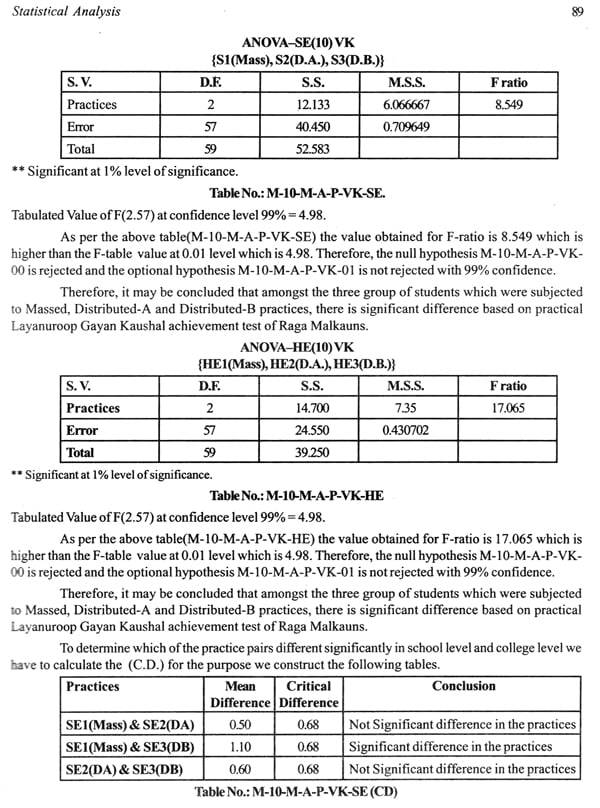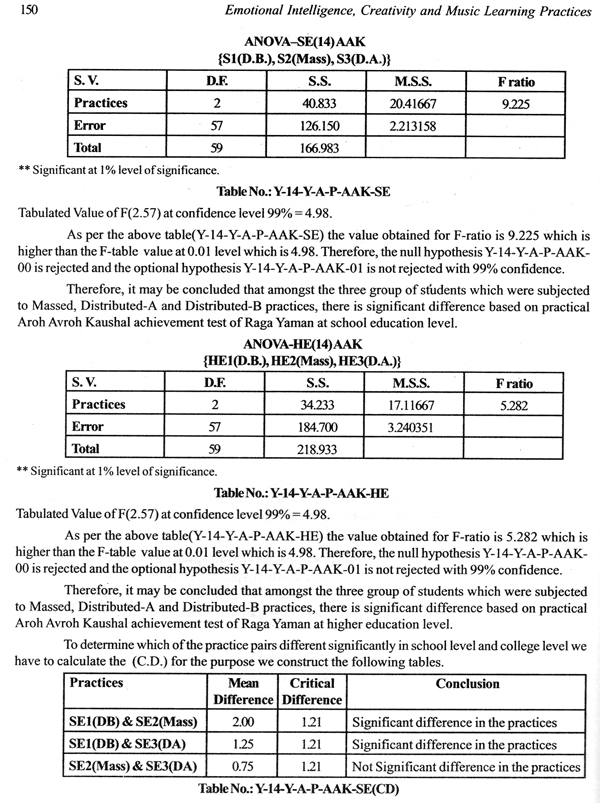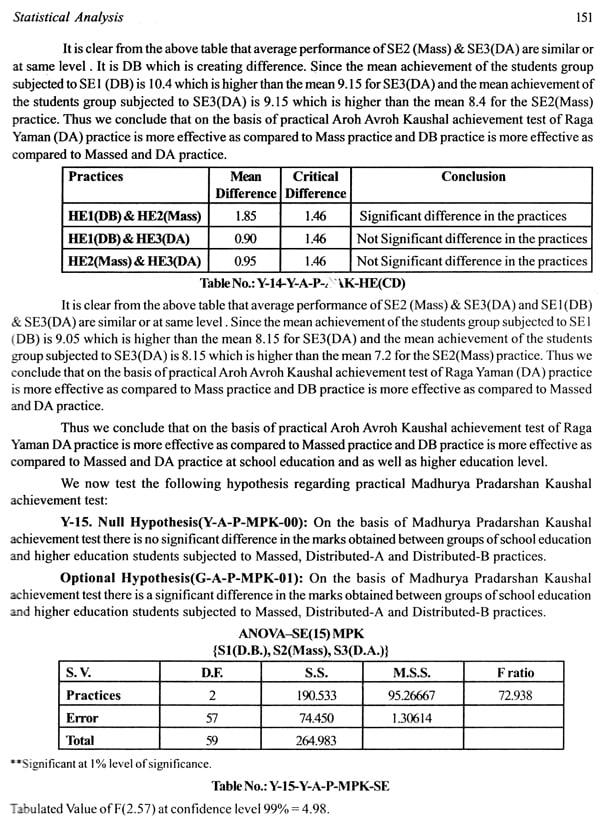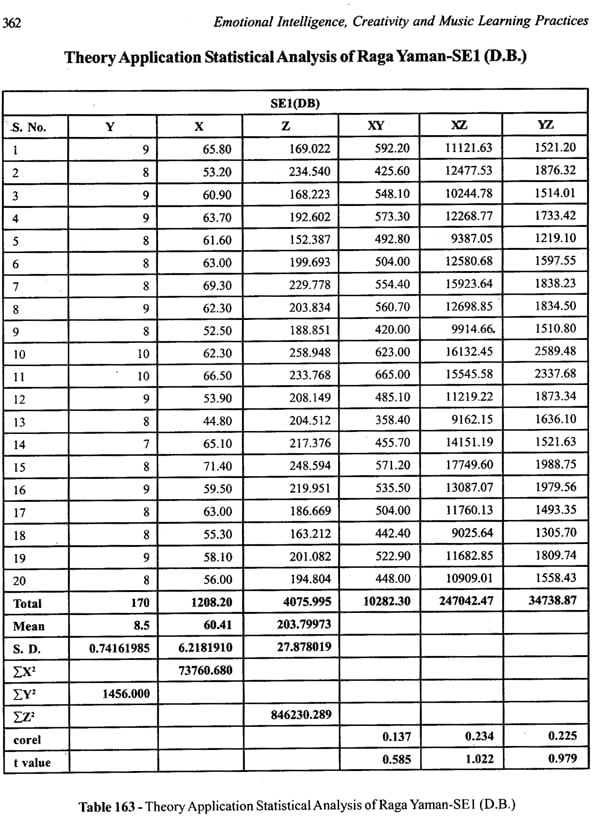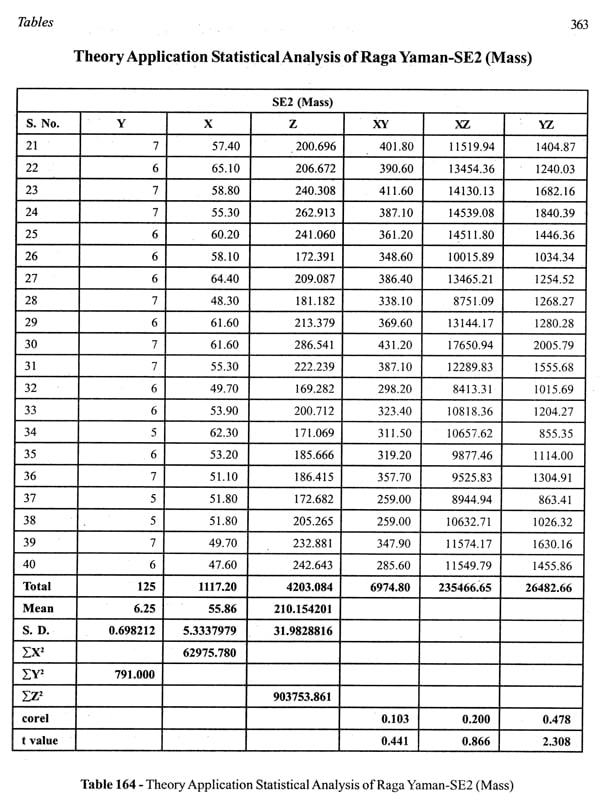
Emotional Intelligence, Creativity and Music Learning Practices
Book Specification
| Item Code: | NAU586 |
| Author: | Ina Shastri |
| Publisher: | Navjeewan Publication, Jaipur |
| Language: | English |
| Edition: | 2007 |
| ISBN: | 9788182680326 |
| Pages: | 540 |
| Cover: | HARDCOVER |
| Other Details | 10.00 X 7.00 inch |
| Weight | 1.15 kg |
Book Description
Music has a humanizing influence and is a powerful factor in the moulding of character. Its study and practice give elegance, grace and refinement to the personality. It has been cultivated from the dawn of human history. It is the noblest of fine arts. It is the language of pure sound.
Learning is defined as "the process by which behaviour is initiated or changed through practice." In conventional usage, practice includes the time spent in both the acquisition and retention phases of learning. We practise to master a skill; having mastered it, we practise to maintain it. Practice may be spaced or massed; i.e., spread out over time or concentrated in a continuous period. Practice arrangements and the impact of distribution of practice on learning have been investigated in depth in the book. It has been a most question for a long time : In the context of music which of the practices is more effective? Massed or Distributed? And with what amount of rest periods in between? To study the impact of different types of practices on vocal music learning we have taken up the following three practices in our study: (1) Massed Practice i.e. practice without any rest period, (2) Distributed-A Practice i.e. 1 hrs. of practice, inter-spaced by 2 hrs of rest period and (3) Distributed-B i.e. 1 hrs of practice, inter-spaced by 24 hrs of rest period. The title of the book defines the scope of study : Emotional intelligences, Creativity & Music learning practices. Three ragas, namely Malkauns, Gaud-Sarang and Yaman for their structural variety have been chosen. All three ragas belong to three different categories- Audav(Malkauns), Vakra(Gaud-Sarang) and Sampooma(Yaman). Furthermore. Malkauns employs Komal Swaras, whereas Gaud-Sarang employs Shuddha Swaras and Yaman has a Teevra Swara. Thus, competency of vocal music in these three ragas is expected to cover the entire gamut of Indian Classical Music. Some of the Statistical tools used are Correlation, Analysis of Variance, F-test in ANOVA, Analysis of Covariance(ANCOVA) and Critical Difference. To successfully carry out any research it is essential that appropriate research methodology be identified. We have adopted the Experimental method.
The novelty of this study is that two new parameters have been taken namely 'Emotional Intelligence and Creativity.' New in the sense that their correlation with musical aptitude and achievement has not been studied so far. The book starts with the common belief that performance of a student depends on his/her Emotional Intelligence and Creativity and then goes on to test this belief.
Dr. Ina Shastri The author was born on the banks of Holy Ganga and came to Holy Saraswati, the premier women's University Banasthali Vidyapith to pursue her higher studies from which University she got her B.A., M.A. (Music) B.Ed. and M.Ed. degrees, all in first class and also Ph.D. She has deep insight in both the disciplines Music and Education. She has read number of papers at National and International Seminars and published a number of papers in referred journals. She has been associated with an innovative teaching programme for B.Ed. "Enriched Anveshana" which has received special mention in position paper on 'Teacher Education for Curriculum Renewal' published in connection with New National Curriculum Framework of NCERT. Also, she has been associated with preparation of course material for 'Arts, Music, Dance & Theatre ' and teacher guide for the same. This book is based on her work for her Ph.D. degree. This work has broken new grounds in research in the discipline of Music. She has a versatile personality. She commanded the NCC contingent at the Republic Day parade in 1986 and was adjudged the all rounder best cadet in India and won many gold medals including those for shooting. She has also won gold medals for music & Dance at Inter University Youth Festivals sponsored by the Association of Indian Universities. Presently she is a Senior Faculty Member in the Department of Music & Dance at Banasthali Vidyapith.
Historically not only in India but in other civilizations also knowledge has been transmitted from teacher to disciple. In India, since Vedic times, a reach legacy of Guru Shishya parampara is found in every discipline. Music is no exception. Great musicians of lore were able to train great disciples who same time excelled even Gums. However, this led to a situation where Music become a preserve of elite class. On the other hand masses had their own musical, traditions, sometimes of great richness. And there arose a dichotomy of classical music versus folk music. It may, however, be mentioned that the two had a subtle relationship because both arose but of the genius of a great civilization. Vishnu Digambar Palusker and later on Vishnu Narayan Bhatkhande made great effort to dose this chasm between music of elite and music of people by making training in classical music available to masses through music schools so that classical music too became music of people. Advent of gramophone helped in putting classical music within the grasp of masses and much later on radio made even greater contribution in this regard. Opening of music schools, and more than that introduction of music as a discipline in schools and Universities raised the important, question ofthe relative efficacy ofthe two systems of teaching music. Music schools could to some extent follow some of the elements of Guru Shishya tradition. The teacher had some flexibility, though not full flexibility, about time spent on teaching different contents and hence pace of teaching. However, in schools and university system even this much flexibility was not possible. Moreover, the possibility of the teacher paying attention to the needs of individual students became very remote. It is argued that Guru Shishya tradition has. even in present times, produced great musicians thus keeping the rich legacy of classical music alive. On the other hand it is argued that it has led to not only the performance, but appreciation of music also a prerogative of handful of people. With the decline of folk music at the same time it has left the field open to film music, where due to lack of talent and creativity in the most of music directors elements of western music have become so dominant that sometimes it becomes difficult to find even traces of Indian music in it. In particular the western rhythms have destroyed the delicacy and intricacies of Indian rhythm system. Introduction of music in formal education system has opened up the charms of Indian Classical Musk to large number of people. Some of whom are encouraged to delve deeper into the mysteries of music_ It is not that this system cannot or has not produced great musicians but that it can in general produce great musicians is a moot question. This controversy about the efficacy of the two has been going on for quite some time. But every time the amine arguments are repeated and we do not see any possibility of resolving this controversy.
**Contents and Sample Pages**
